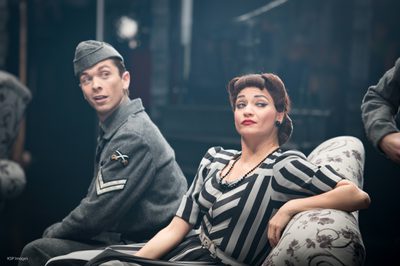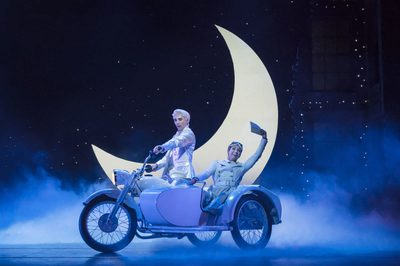Comparisons
Differences between Matthew Bourne's Cinderella and the traditional fairytale
There are many versions of the story of Cinderella, with the earliest known version having been written down in China during the 9th century. This classic, and now well-loved tale, has been the basis for a long list of pantomimes, operas, and ballets. The earliest Cinderella ballet proper was by Duport in Vienna in 1813, whilst London's first complete Cinderella ballet was seen in 1822.
Marius Petipa, Lev Ivanov, and Enrico Cecchetti choreographed Cinderella for the Imperial Mariinsky Theatre in 1893 to the music of Baron Boris Fitinhof-Schel. It was in splendid production that Pierina Legnani was celebrated for her impressive feat of performing 32 fouettes—though sadly, none of the choreography has survived. Adeline Genee first danced the title role of Cinderella at the Empire, Leicester Square, on Twelfth Night 1906. Then, 29 years later to the day Andree Howard choreographed her one-act Cinderella, (in which Frederick Ashton was the elegant Prince) for Rambert's Ballet Club at the Mercury Theatre, Notting Hill Gate.
Matthew has taken inspiration from a great many productions of the fairytale including some of the many stage productions and films that have been made. Amongst those that Matthew recalls seeing are Disney’s animated movie from 1950, as well as the National Theatre’s pantomime version from the mid 1980’s. However, it was Frederick Ashton’s production of Cinderella, made for the Royal Ballet, in 1948, that had the biggest impact on Matthew, and which inspired him to create his own version.
Matthew first saw Ashton’s Cinderella performed in 1980, and saw it again many times in that decade. Antoinette Sibley and Anthony Dowell’s performances in the lead roles of Cinderella and the Prince, particularly struck Matthew, and he was also fascinated by Prokofiev’s score – which he loved but which, at first, seemed very challenging, as it was quite different from the music Matthew had heard in other ballets.
Below we explore some of the similarities and differences between these two particular versions:
Characters
Ashton's Cinderella is his own imagining of a Petipa ballet, and the ballet itself notably sees Cinderella realising her dreams. When we first see her she is a demi-caractere dancer dreaming of being a ballerina, which is seen in her solo with the broomstick in the kitchen — and it is as a ballerina that she magically enters the ballroom, stepping en pointe down the stairs and advancing in pas de bourree to the front of the stage. Back in the kitchen she recalls the slipper (or rather the pointe shoe) that she carries in her apron; the shoe is the clue to her dream and persuades her it was true. The Prince finds Cinderella, but in his arms she discovers her own identity as a ballerina.

Matthew's Cinderella is an odd, put-upon create with an inner goodness and a highly developed creative imagination. Her appearance is simple, if a little frumpy, yet she longs to be beautiful and sophisticated. The world is sometimes more real to her than her lonely existence and home and is fed by her love of movies and Hollywood glamour. She is mostly ignored by most of the household and treated like a servant by her step-family.
The Wicked Stepmother, in almost all other versions of Cinderella, is who Cinderella lives with. However, Ashton chose to do away with this character, and had Cinderella living just with her two sisters, and her feeble father, instead.

Matthew’s version includes the character of the stepmother, though ‘wicked’ (used in almost all other versions) is absent from her title. Instead she is a rather glamorous-looking figure, albeit rather stern and forbidding, inspired by actresses who have played stepmother roles in movies, including Joan Crawford and Bette Davis. Her ‘wickedness’ is displayed in her behavior toward others, especially Cinderella.
Sybil (as she is known) prizes material possessions above all else and her selfishness knows no end. Even her own daughters are a sexual threat. There are many secrets in Sybil’s closet, and Cinderella is convinced that she had something to do with her mother’s death, and her father’s ‘accident’. Sybil is noticeably uncomfortable when Cinderella is around and hopes that if she keeps her silent stepdaughter locked away, her terrible secrets will not get out.
The Prince – this character is really the classic charming, handsome Royal you would expect. Ashton decided to use Prokofiev’s score for his version of Cinderella, partly due to the fact that he sympathised with the score’s intentions and emotions in signifying ‘the poetic love of Cinderella and the Prince, the birth and flowering of that love’. The Grand Pas de Deux for the Prince and Cinderella takes place at the ball in Act II, rather than at their wedding celebration in Act III as would have been typical of other ballet versions. Ashton also decided to remove the Prince’s round-the-world search for Cinderella that was a feature of Russian versions.

The Pilot – instead of a prince Matthew decided to make Cinderella’s love interest a Fighter Pilot in the Royal Air force instead. This was much more in-keeping with the war-time Britain setting and, since the RAF were often viewed as the most ‘glamorous’ and impressive of the services it set him apart from the other characters. Matthew kept the same structure as Ashton in terms of the main duet for Cinderella and her ‘prince’, (known as Harry), appearing in Act II at the Café de Paris, as well as keeping the Pilot’s searches for Cinderella confined to one location – London.
Prone to panic attacks and recurring nightmares Harry has seen many of his young friends die or wounded horrifically. Injured whilst making an emergency ejection (by parachute) from his flaming plane he arrives in London, confused and homeless. Find out how company dancer, Andrew Monaghan, gets into character as Harry (The Pilot) in the video below!
The Fairy Godmother – when an old haggard woman comes to Cinderella’s house begging for money, Cinderella is the only one who takes pity and offers her some bread. Later on, as the two Ugly Sisters do their hair and make-up, and depart for the ball, we see in the background the shadow of the beggar woman who now materialises as Cinderella’s Fairy Godmother.

The Angel – this guardian angel is a male character. Elegant, ethereal, and dressed in a shimmering white tailored suit, this character is pivotal as he determines Cinderella’s fate, (as well as that of other characters). Whilst we see him help Cinderella, we know that he has an influence over many things, including determining when people’s time ‘is-up’, as he also takes on an ‘Angel of Death’-type role.
The Ugly Sisters – unlike in Russian ballet versions of Cinderella Ashton opted to feature the stepsisters ‘in travesty’ to honour pantomime tradition. That is to say, Ashton’s Ugly Sisters were shown as absurdly distorted representations of how Cinderella’s sisters might have been imagined. For example, the sister played by Robert Helpmann wore a large pantomime-esque nose.

The Step Sisters – as with the stepmother, the ‘ugly’ adjective was removed from the sisters’ title in Matthew’s version, they are simply The Step Sisters.
Irene is an attractive, self-centered and pushy, the war is a major inconvenience to her and her social life. She likes a man in a uniform however, and the arrival of the Americans has been an exciting distraction. The weekly fashion magazines are her ‘bible’ and she somehow manages to look stylish despite the rationing. The second sister, Vivien (pictured) is stroppy, moody and bitter.
She’s disappointed with her life and irritated by her family. Vivien resents not having a ‘proper’ father, as she is naturally a bit of a tomboy. Her doting boyfriend, Stan, is totally dominated by her, and she shows him no appreciation. She would like to join the Wrens, or some such organisation, to get out of the house but is naturally lazy and has not gotten around to it.

Also appearing in Matthew's version are three stepbrothers, characters that are not seen in other versions of Cinderella. Partly a logistical consideration to enable more parts for the company, and partly to create a busier household for Cinderella to exist in, these stepbrothers create more grief and strife for Cinderella. Stan, Vernon, Elliot are quite different in nature, and all create different challenges for Cinderella. However, it is the middle brother, Vernon (pictured), who perhaps causes her the most angst due to the rather unhealthy obsession he has with her, which marks his rather deviant nature.
The other characters in Matthew’s Cinderella play various roles from service men and women, members of the Air Raid Precautions (ARP) Teams, London citizens living through The Blitz, Café de Paris party-goers, and medical staff. They represent the all the many facets of lifetime during Britain during World War II.
Era
Ashton's Cinderella and the traditional story was set in an unmarked era, a classical and fantastical time, whereas Matthew's Cinderella was set in 1940s London. Inspired by the knowledge that Prokofiev wrote his Cinderella score between 1940 and 1944 during World War II, Matthew chose to set his version of Cinderella during the early 1940’s whilst Britain was at war. Centered in London during the Blitz, the score takes on new meaning against the backdrop of conflict.
Design

In the original fairytale Cinderella rides to the ball in a Pumpkin Carriage. The Fairy Godmother tells Cinderella that, as a reward for her kindness, she shall go to the ball in the most beautiful dress of all. But she also warns her that she must leave before the clock strikes midnight, or all the magic charms will fade away and Cinderella will be a scullery maid once more. Cinderella is sent to fetch a pumpkin that she grew in her little kitchen-garden, and it is instantly transformed into a luxurious carriage. Dressed in shimmering white, Cinderella rides away to the ball.
In Matthew's Cinderella we see Cinderella riding off to the ball with the Angel in a Motorbike and Sidecar. At the end of Act 1 Cinderella and the Angel briefly leave the stage before returning together in a motorbike and sidecar. Partly a practical design decision (to find a vehicle that like a carriage would enable both characters to still be seen whilst they drive off), this has also become a moment in the show that is both playful and poignant for it is the Angel himself who takes Cinderella to the ball, thus reinforcing the idea that he has, at least partially, some control over her destiny. White and shimmery much like the Angel’s costume, and much like you would expect any fairytale ‘carriage’ to be, this design element neatly bridges the gap between classic fairytale and the real-life events of war-torn London, in which the show is set.
Go Back